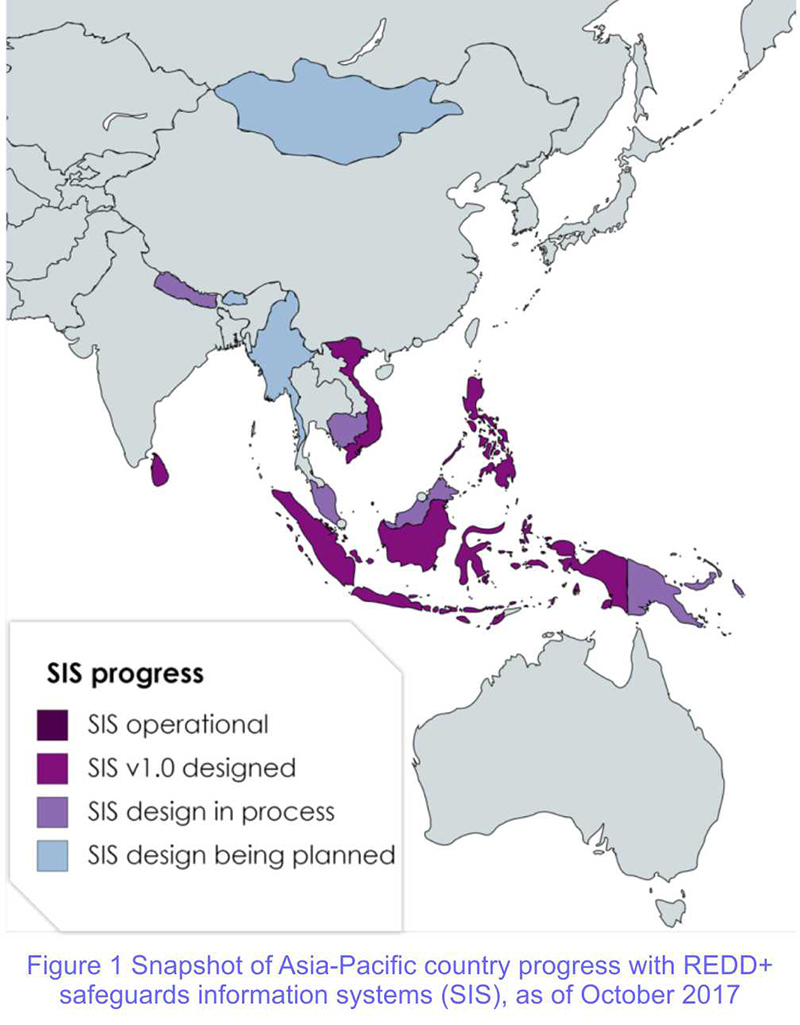Representatives from nine different Asia-Pacific countries – Bhutan, Cambodia, Indonesia, Lao PDR, Mongolia, Myanmar, Nepal, Papua New Guinea and Viet Nam – gathered in Hanoi in November to share experiences and lessons from meeting safeguards requirements for REDD+ at a South-South knowledge exchange hosted by the Viet Nam Forestry Administration. Guests representing the two other tropical forest regions where REDD+ is being pursued – Ghana for Africa, and Peru from Latin America – were also present.
Under the United Nations Framework Convention on Climate Change, countries choosing to implement REDD+, and obtain payments for measured, reported and verified greenhouse gas emission reductions, are required to develop a national-level safeguards information system. This is to show how the ‘Cancun safeguards’ for REDD+ are being addressed and respected when implementing REDD+. A national safeguards information system is also an eligibility criterion for REDD+ result-based payments under the Green Climate Fund.
How have countries in the Asia-Pacific region progressed with the development of their safeguards information systems, and how does this progress compare with Africa and Latin America?
No country has been able to fully operationalise a safeguards information system as yet. About one third of the Asia-Pacific REDD+ countries have designed their systems – at least on paper. Indonesia and the Philippines have online web platforms for beta versions of their safeguards information systems. Another third are in the process of designing their systems, while the remaining third are still in the planning stage of the design process (see Figure 1).
This is similar to the current state of safeguards information system development in Africa. Latin America is slightly ahead of these two regions, and has more countries with safeguards information systems designed, or in the process of being designed, and fewer countries at the initial planning stages.
The Cancun safeguards, and the need to develop a safeguards information system, were agreed seven years ago. Why does a fully operational system to track safeguards implementation remain elusive after all this time?
While the participants of the Hanoi workshop identified a variety of design challenges for safeguards information systems, those that resonated across most countries include:
-
Limited operational guidance provided under the climate change convention. No design blueprint can be replicated from one country to another because each country’s circumstances are unique; each system has to be tailored to each country’s specific context.
-
Limited technical capacities, among government and other stakeholders. The information system, by itself, will not address and respect the safeguards, and identifying what information is needed, to go into the system, to demonstrate this addressing and respecting, have been the main conceptual challenges faced in the Asia-Pacific region.
-
Compiling information from existing sources and systems, interpreting the Cancun safeguards defining information needs and structure, and finally developing different templates to collect information from different sources has been a complex and lengthy process.
-
Relying on existing systems, as per international guidance, has proved to be a fundamental limitation for some Asia-Pacific countries, who have discovered either: a) big gaps in thematic coverage of some of the safeguards; or b) not enough detailed information to demonstrate that the safeguards are being respected.
-
Frameworks of principles, criteria and indicators, to structure the safeguards information systems, have all too often proved to be complicated and protracted processes also, with end-products of questionable utility. Such frameworks were typically developed before clarity on the REDD+ actions, as articulated in the national strategy, was reached.
As safeguard processes in the Asia-Pacific region mature, REDD+ countries will face new challenges in putting their safeguards information system designs into operation. Ensuring appropriate institutional mandate backed by political support; aggregation, analysis and quality assurance of information from multiple sources and scales; and identifying incentives for different existing sources to share information with a central host agency, are some of the main anticipated operational challenges on the horizon for the region.

